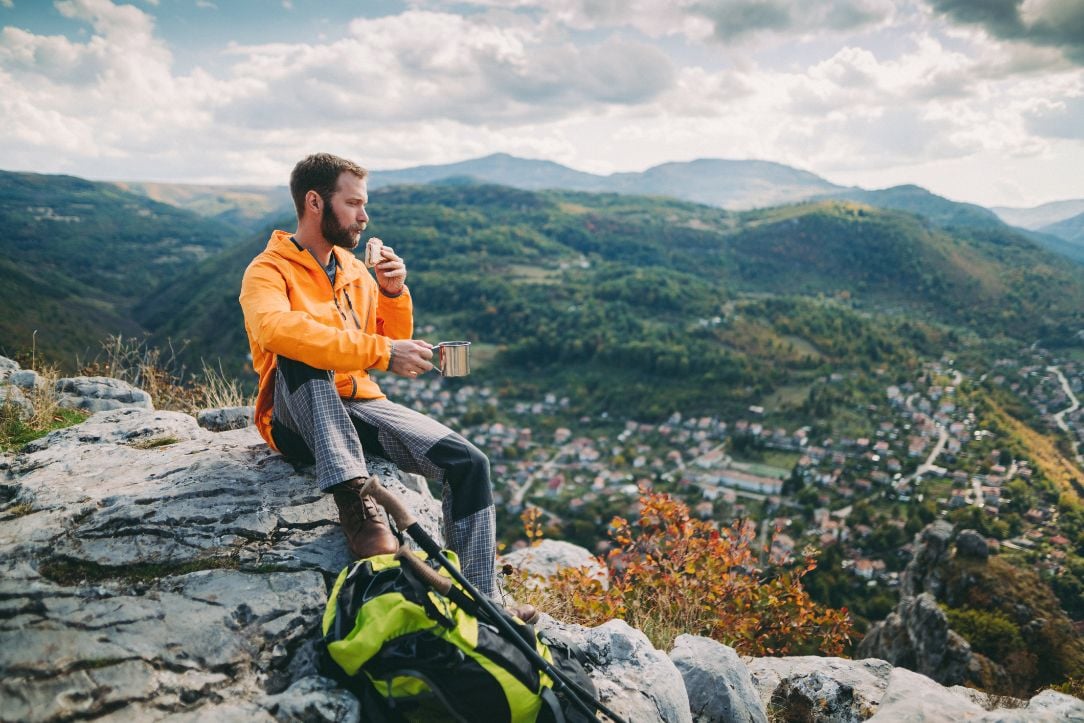Hiking snacks come in all shapes and sizes. Go on a long enough hike and they'll turn into basically the only thing you talk about. Fantasise about that slice of cold pizza or packet of midget gems. Regret not putting nuts in your trail mix or packing any fresh fruit. Make plans for the next time you see a shop.
This article is going to make you hungry. So if you're even slightly peckish, go and grab a biscuit to fortify yourself against the snack-fest to come.
Why Do I Need Snacks for Hiking?
How important you think hiking snacks are probably depends on if you're a grazer in everyday life. If you munch your way between lunch and dinner, this might not be a hard sell. If you've got a hunger graph with three delta-functions at 7:30, 13:00 and 18:00, then hiking snacks probably need some explaining.
The thing about going on a hike is that you use up a lot more energy than if you are sitting at a desk all day or lying on the sofa watching Netflix - around 400 and 600 calories an hour, in fact. While you might get away with eating just three big-ish meals in a normal day, on a hike that will most likely leave you hungry before and wanting a nap after.
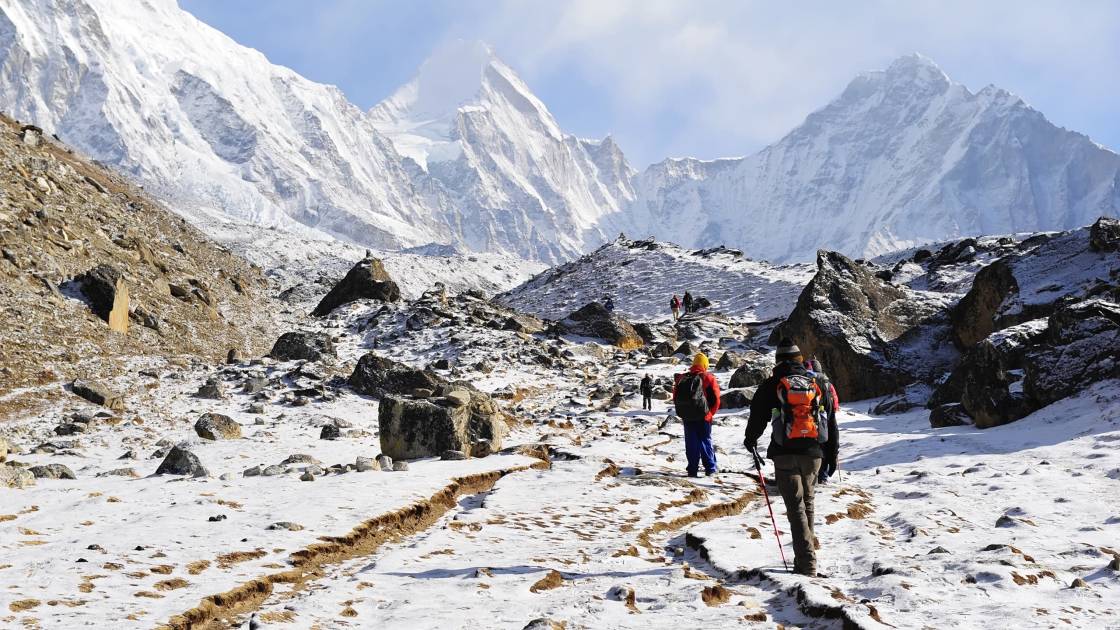
When you hike, in fact, you might not always feel super hungry. That's not just because you're distracted by the amazing views - it's also because all the blood and oxygen is going to your muscles rather than to your stomach, which makes you feel less hungry. Being at altitude can also affect your appetite.
We're not scientists, but you can think about yourself a bit like a machine when you're hiking. Food in means fuel and therefore energy to keep your legs going. Since you're always moving throughout the day, you're better off having a constant level of energy than one with big peaks and troughs. A good rule to follow is that you probably need to eat something around every hour. So lots of small meals - aka snacks - throughout the day are better. Savvy?
What Makes a Good Hiking Snack?
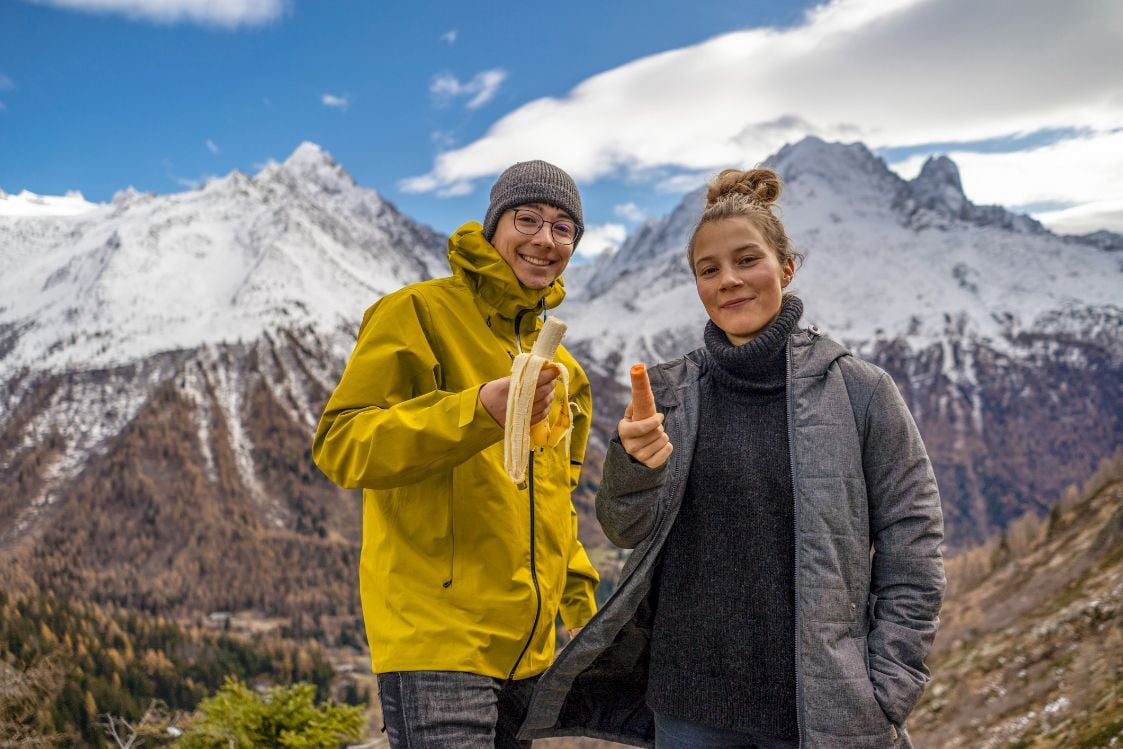
There are so many factors involved in finding the best hiking snack, one that's perfect for your hike. Firstly, the weather and temperature where you're going hiking is a big one. Take the humble chocolate bar. Too hot and it turns to a suspicious squidge inside the wrapper. Too cold and its so hard it'll break your teeth. The same goes for things like caramel and other sugary bars - there's a reason people claim to have belayed off frozen Mars bars.
Then there's the shelf life, how long your lovely hiking snack will stay fresh and tasty. This is far less of an issue for day hikes, but if you're on a long distance walk or trek you should consider it. Fresh fruit and veg might go mouldy, for example. With this is the structural integrity of your snack: how well can it cope with travelling? Will it survive being crammed in a side pocket of your rucksack?
You could carry fresh fruit or dried fruit - less space and weight, less refreshing on hot days
Another fact to consider is the snack's weight, size and packaging. Ultralight hikers will usually tut at the idea of carrying anything in a tin. It's bulky and heavy compared to a ziplock bag, for example. You could carry fresh fruit or dried fruit - less space and weight, less refreshing on hot days. Ultimately it's your choice, but remember you have to carry it all!

Finally - and critically - will you actually want to eat the snack while you're out hiking? This might sound mad. Of course I'll want to eat my favourite brand of biscuits! But you might find your tastes change while you're hiking. Or, more often than not, foods that taste amazing in the mountains taste pretty mediocre back home. It's also a rookie error to pack your body weight in sugar and be sick at the sight of Haribo by the end of the trip. Balance is key, but we'll cover that in more detail later.
A bad snack is one that you don't want to eat or regret carrying. Or one that gets so destroyed you can't eat it (melted chocolate bars, we're looking at you). Or something with a huge amount of packaging that's a faff to carry and dispose of. But don't worry, most of us learnt this all by trial and error. If you go hiking often enough, you'll quickly discover what works for you.
How Many Hiking Snacks Should I Bring?
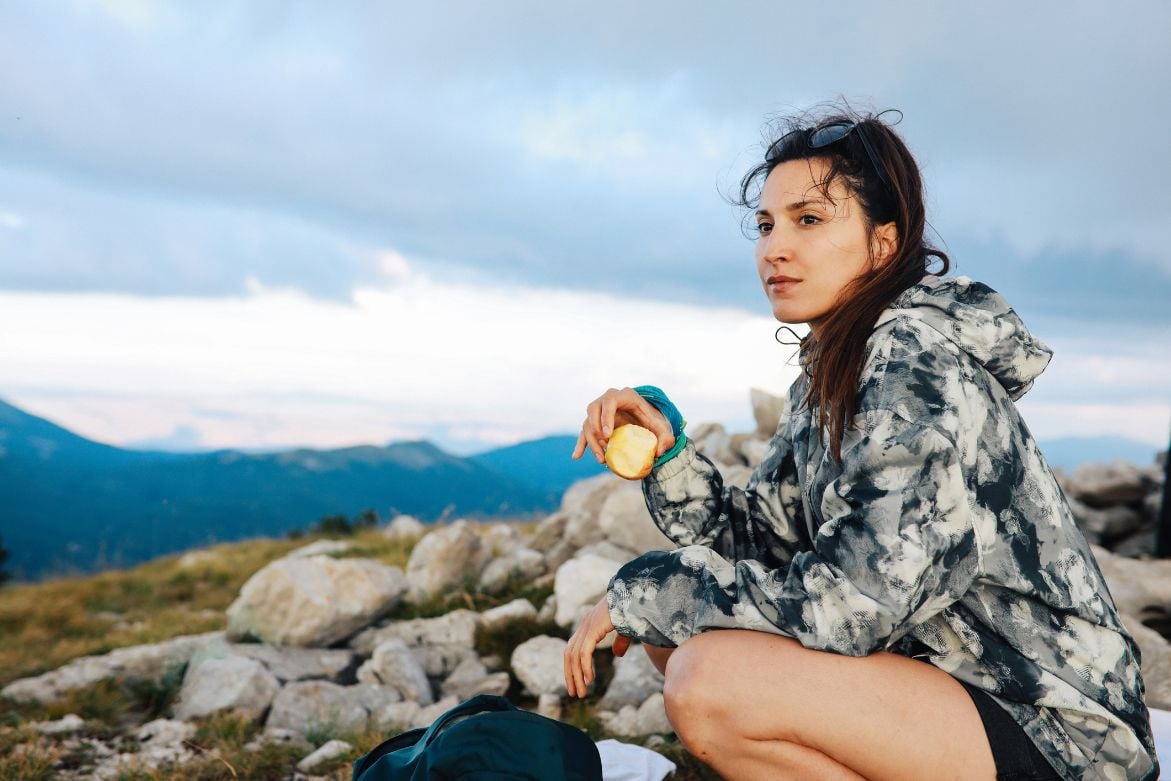
How many hiking snacks you bring with you really depends on what type of hiker you are, how far you are walking, over how long, and how much ascent is involved. It will also depend on the amount of weight you're carrying, which is why lightweight snacks are so crucial on longer trips. Input your weight, trail length elevation gain and more into this hiking calorie counter for an idea of the amount of calories you'll need per day.
According to Black Iron Nutrition, on a standard day hike you'll likely need to consume around 200-300 calories per hour. A banana contains around 90 calories and 100 grams of beef jerky is around 400 calories. Don't get too hung up on the numbers on shorter hikes, though.
If you're going on a multi-day hike, you'll probably find you want more snacks per day the further into the trip you get. Anecdotally, this is because you've used up some or all of the energy reserves you had when you started. Make sure to pack yourself something especially tasty.
Hot vs Cold Weather Hiking Snacks
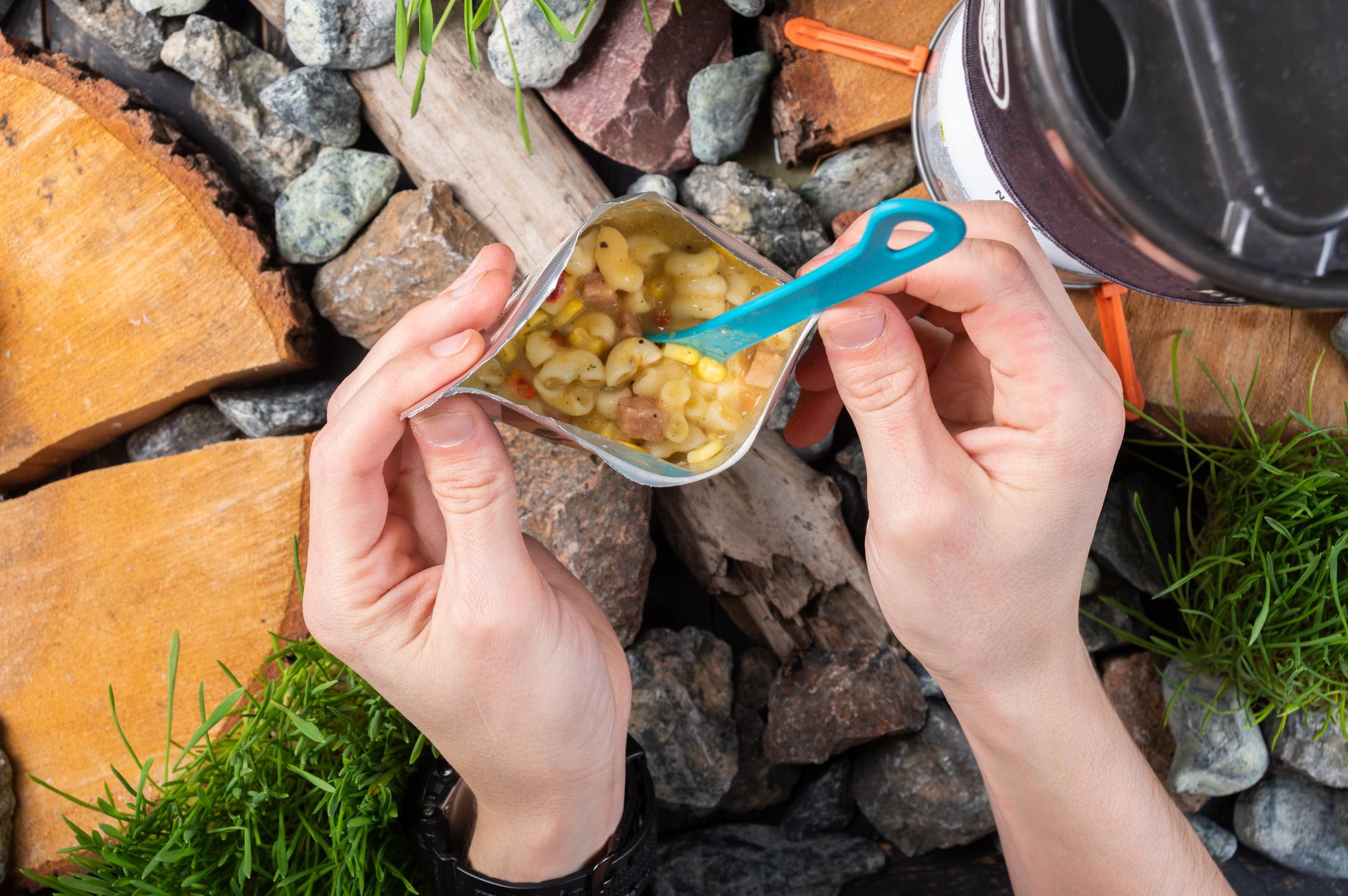
You have slightly different preoccupations when hiking in hot and cold weather. In cold temperatures, your preoccupation is staying warm. If you're cold, you shiver, and then you burn more calories. Of course, having the right cold weather hiking gear is important, but your hiking snacks can also help keep you warm. Eating can keep you up to 10% warmer than if you have an empty stomach - an effect known as thermogenesis. Calorific, high-fat snacks are good here (homemade flapjack is our top choice). We'd also recommend hot snacks - such as a flask of hot chocolate or soup.
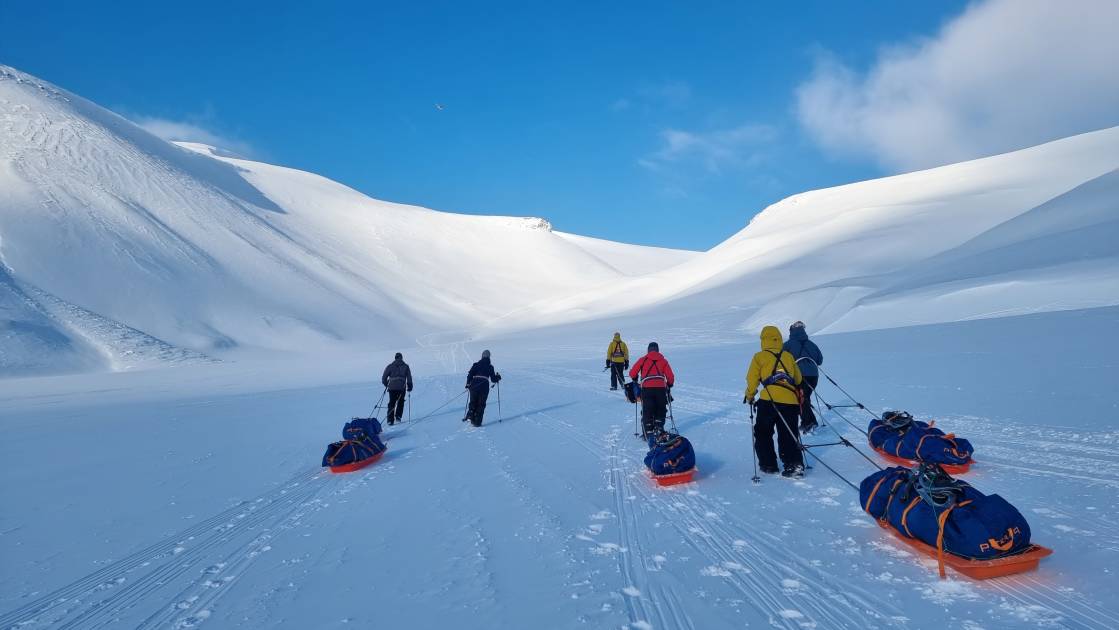
Hiking in hot weather, your main worry is fluid loss. When you sweat, you lose electrolytes - salt, potassium, magnesium, and calcium - which need to be replenished as you hike. You can drink an energy drink or electrolyte gel, but lots of snacks contain electrolytes too - banana chips contain salt and potassium.
Meet the Queen of the Hiking Snacks
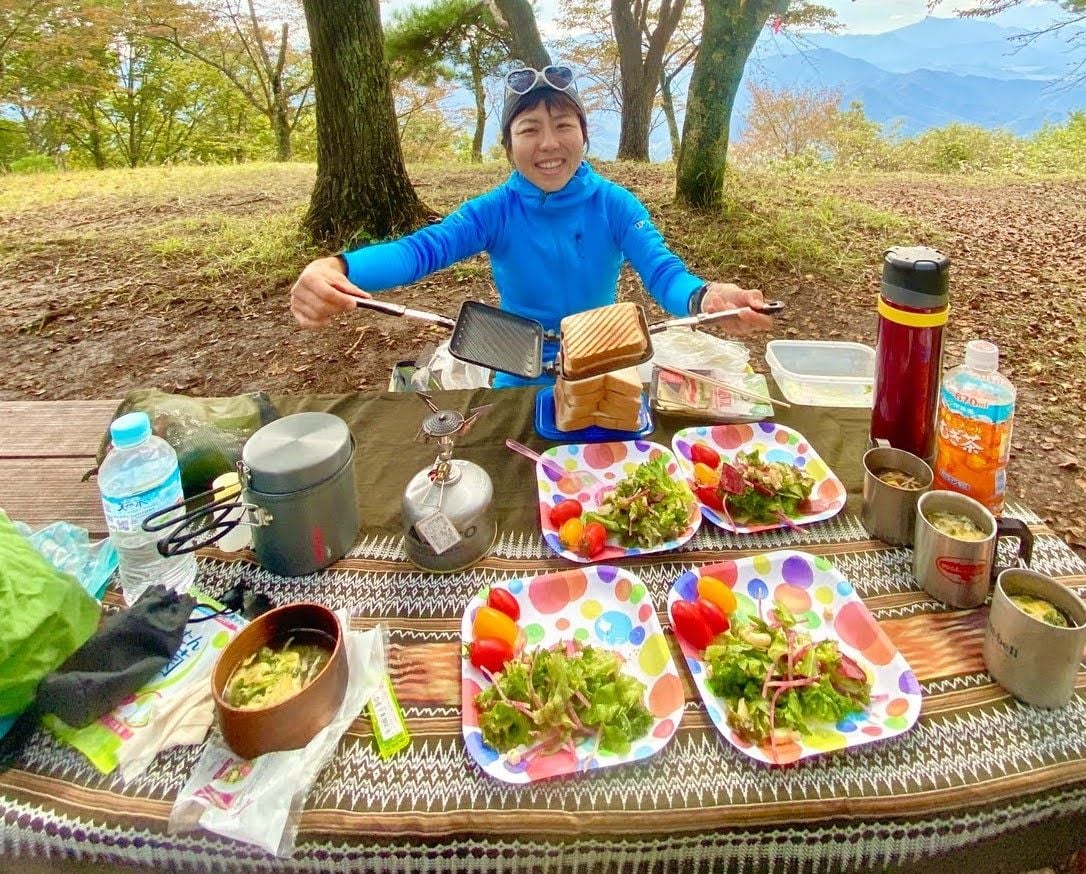
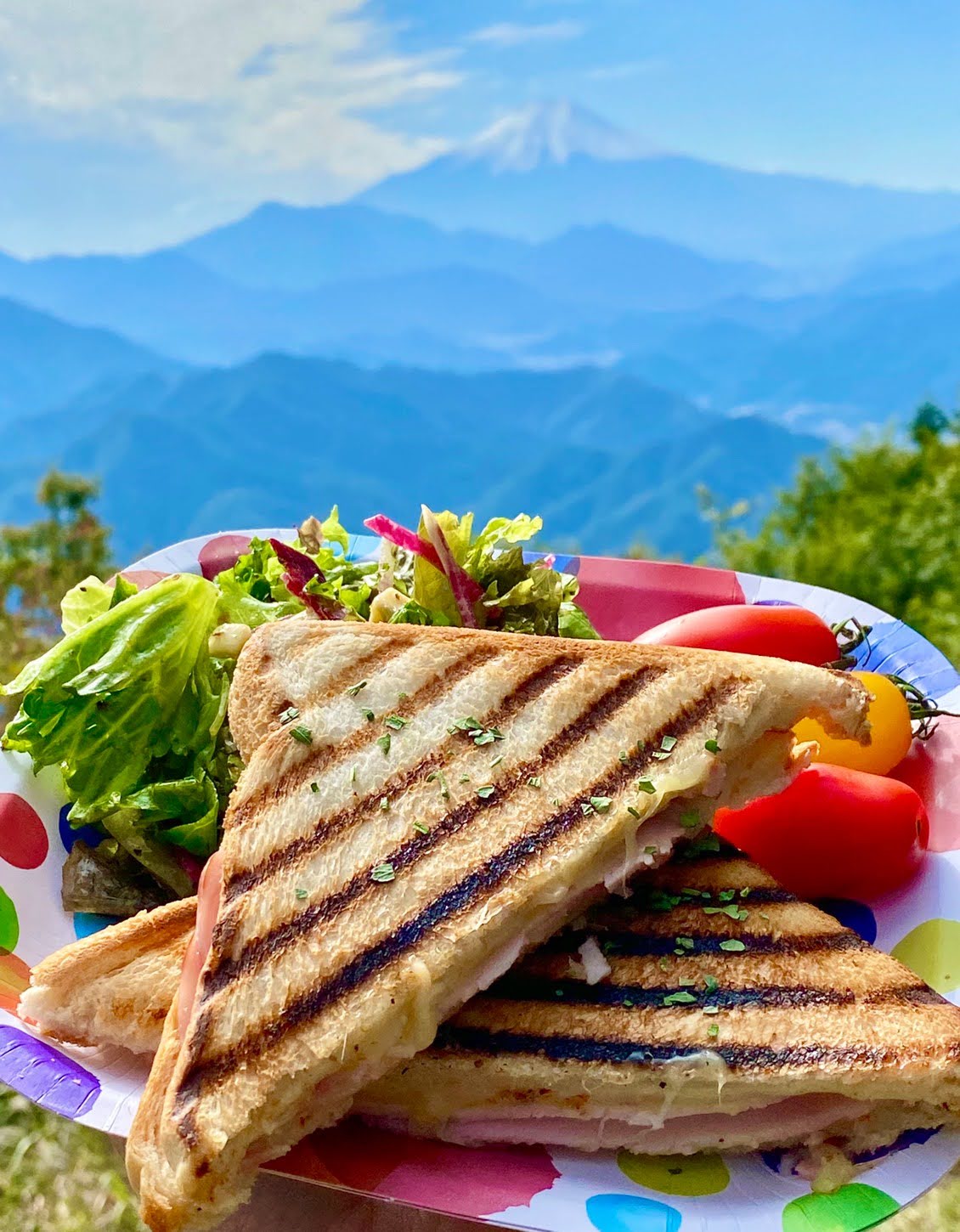
Akiko Suzuki, queen of the snacks!
Akiko Suzuki, a hiking guide in Japan, is the unofficial snack queen! She believes that Japanese omotenashi (hospitality) extends onto the trail. One of her favourite hiking snacks is ohagi, rice cake covered by sweet red bean paste, but for lunch she goes all out. With a frying pan that doubles as a sandwich maker she produces ham and cheese toasties - and that same pan is used again to make caramelised apples for desert.
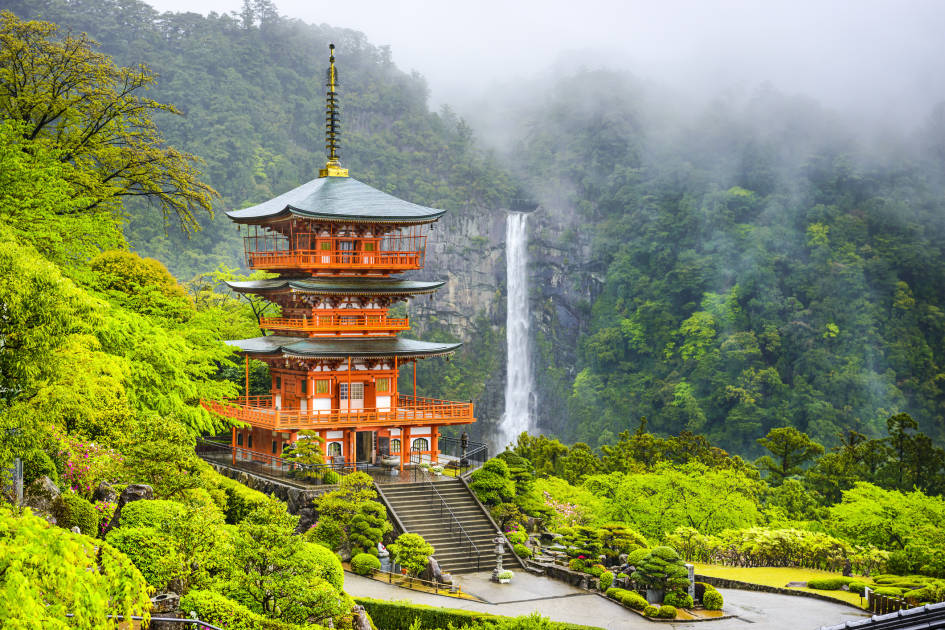
"I always bring a drink and fancy glasses (plastic ones) to toast at the top of mountain," she says. I cook and provide a proper lunch on the mountain, and make sure to bring cute designed plates," she says.
One of our favourite ideas Akiko suggested was to bring roll-your-own sushi - you'll need pre-cooked sushi rice, nori sheets and a ziploc bag full of raw and pickled vegetables (we'd steer clear of raw fish if we were you).
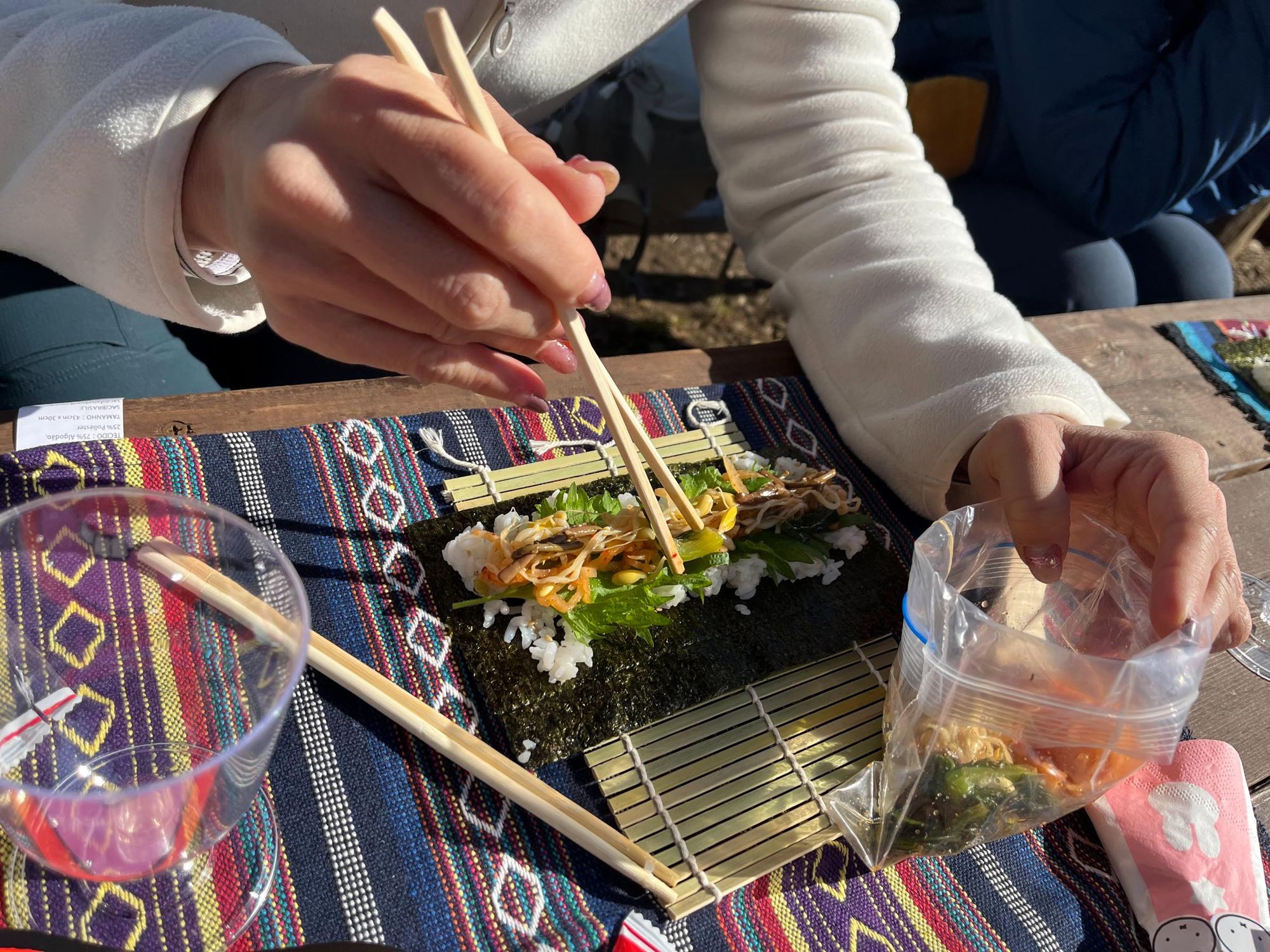
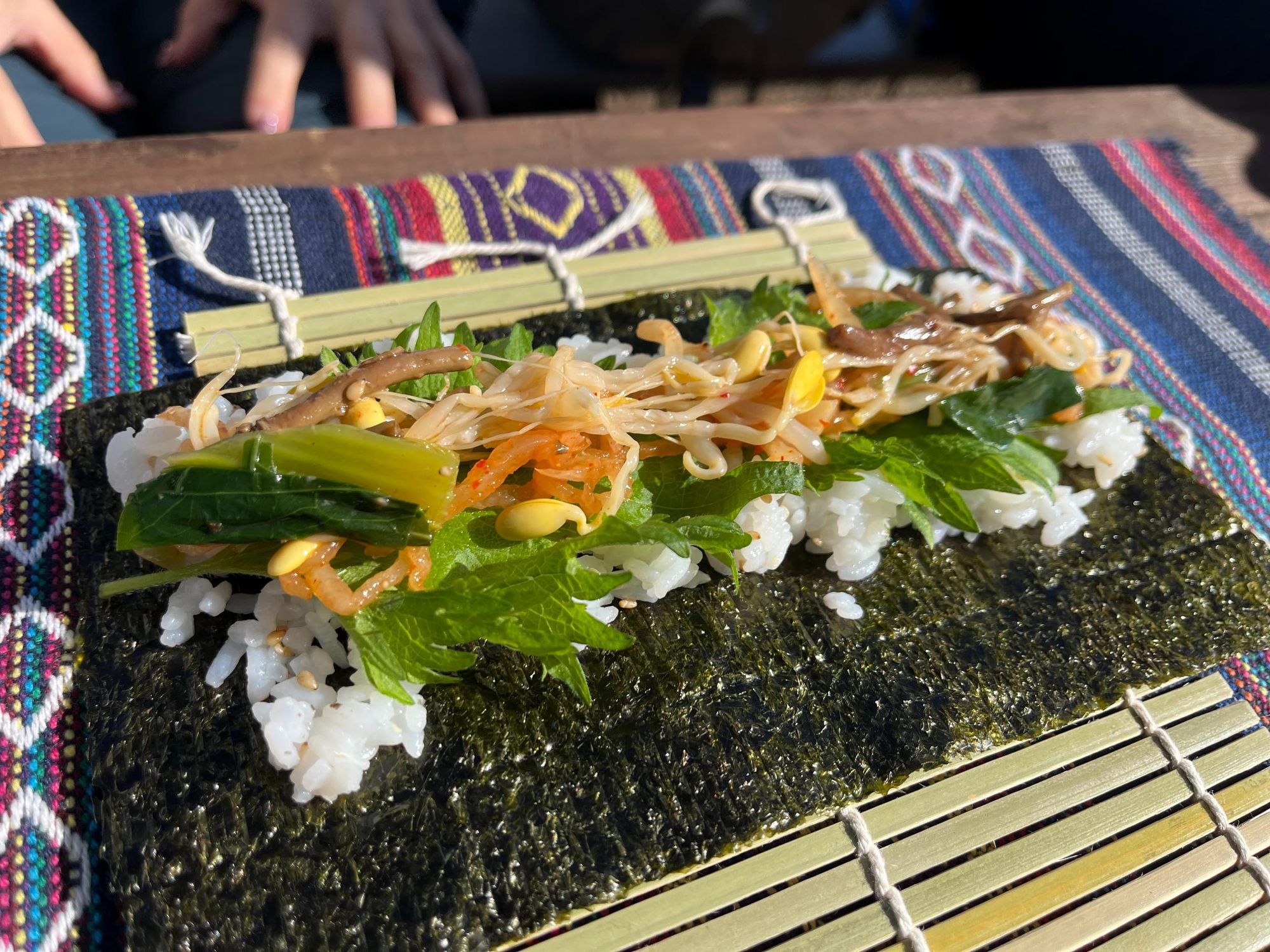
Preparing sushi as a hiking snack on the trail. Photo: Akiko Suzuki
How to Balance Out your Hiking Snacks
As we've said, the best sort of hiking snack is one that you'll actually want to eat. We also find that the less like 'proper' hiking food your snack is, the more exciting. It's far easier to get excited by pizza than another handful of raisins. Unless you're really into raisins.
As tempting as it might be to simply pack sugar, it's important to get a balance of food groups. Sweets are great for a quick burst of energy if your hike suddenly becomes a lot more intense or you feel yourself hitting the proverbial wall. Carbohydrates are very important for a hike - they're basically your body's most important source of fuel, as your body converts them to glucose, aka energy reserves.
Over longer trips - say a week or more - getting a balanced diet becomes more important. Make sure you're eating fibre (found in fruit and veg) and protein - the latter helps repair and rebuild muscle after exercise. You'll also need to keep hydrated.
Some kind of hydration or carb drink is very common for both running and cycling as it's very efficient
"Some kind of hydration or carb drink is very common for both running and cycling as it's very efficient," says James, our Adventure Operations Manager and keen ultra-runner. "Over-hydration (hyponatremia) is a dangerous issue where people drink too much water and their salt levels drop too low - it's important on long efforts to get the electrolytes in too. When it comes to snacks, My personal favourites are snickers bars and cheese and pickle sandwiches."
For most people, it'll be a choice of sweet and savoury. So without going into the details of macronutrients and all that jazz, here are some examples of things you might like to pack on a hike.
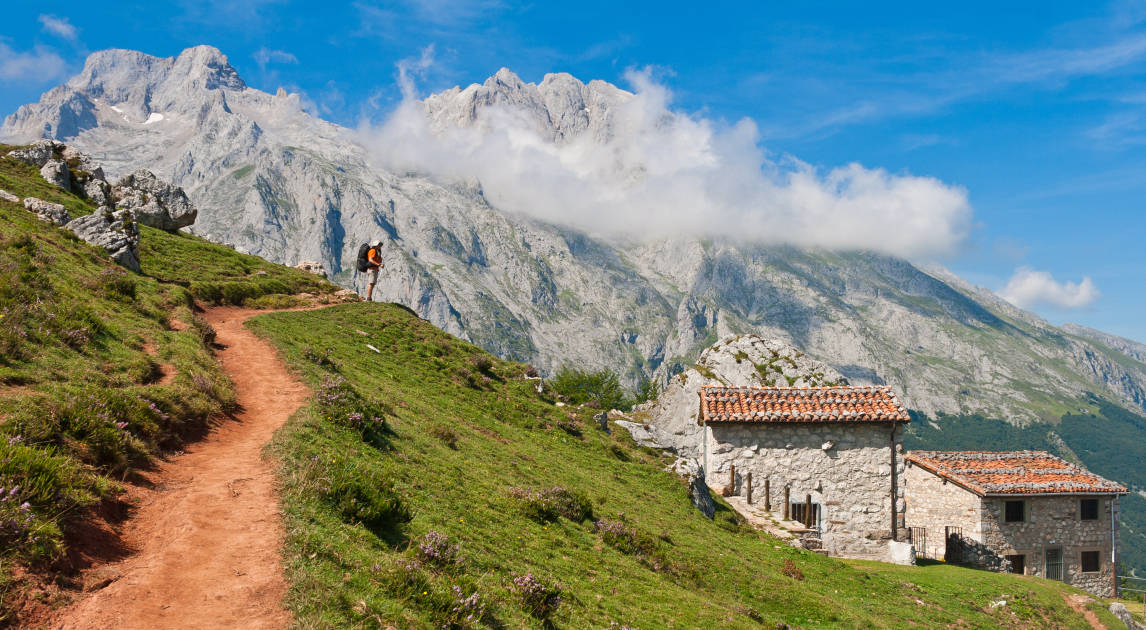
Sweet Snacks
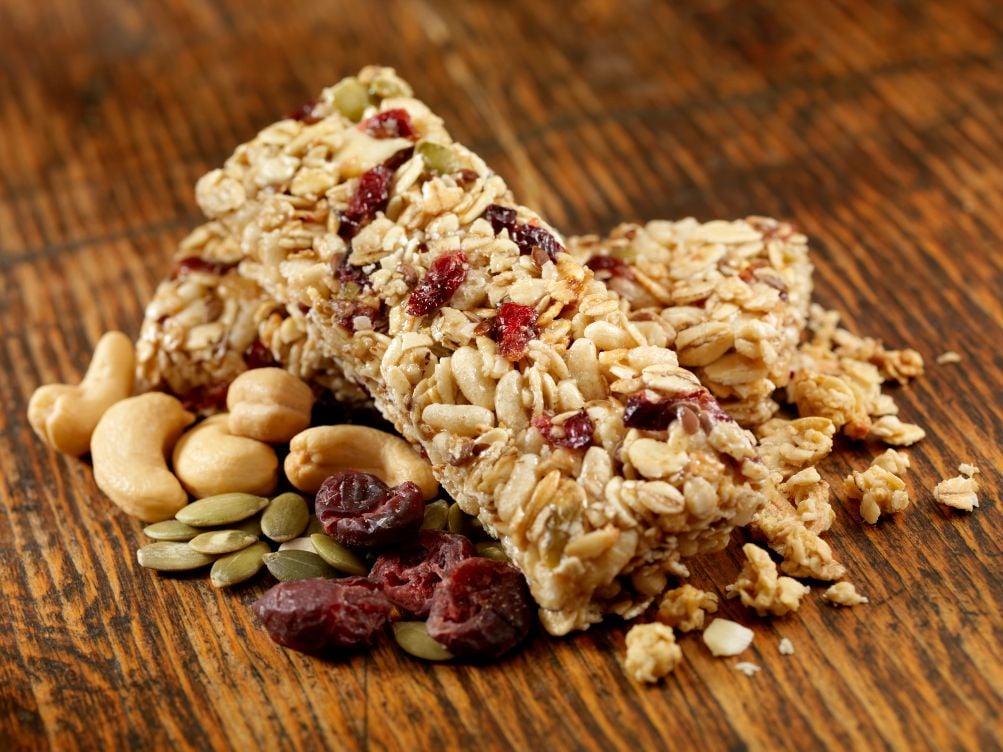
Run to the biscuit aisle of your favourite shop and help yourself. Well, obviously pay, but biscuits and cereal bars are a staple for hikers. Flapjacks, digestives, chocolate-coated Hobnobs... go wild. The same goes for packets of sweets, whether it's marshmallows or liquorice or emergency jelly babies. Every now and again you'll find someone eating jelly cubes neat out the packet.
"I really enjoy the mini banana bread Soreen as a hiking snack. Even after getting squashed flat at the bottom of your bag they’re still great. Also they don’t go weird and sweaty in their packaging when it’s warm," says SEO Manager Lauren.
"In Alaska - and I assume elsewhere in the US - the packs of trail mix had M&Ms in. Big fan of that," adds Chris, our Adventure Expansion Manager.
I make my own no-bake energy balls with nut butter, oats and whatever dried nuts and fruit I have lying around in the cupboard
We'd also put dried fruit in the sweet section, although it's probably better for your teeth than Haribo.
"I love Gold Bears," says our Founder Guy, who recently completed a 3,500 kilometre cycle ride across Europe. "And Snickers...waay cheaper than the alternative energy bars, and basically the same thing."
Raisins and sultanas are classic. Apple, pineapple, mango and banana all come dried. Dates are basically pure sugar. You could definitely mix up dates with oats and seeds to make your own energy balls too.
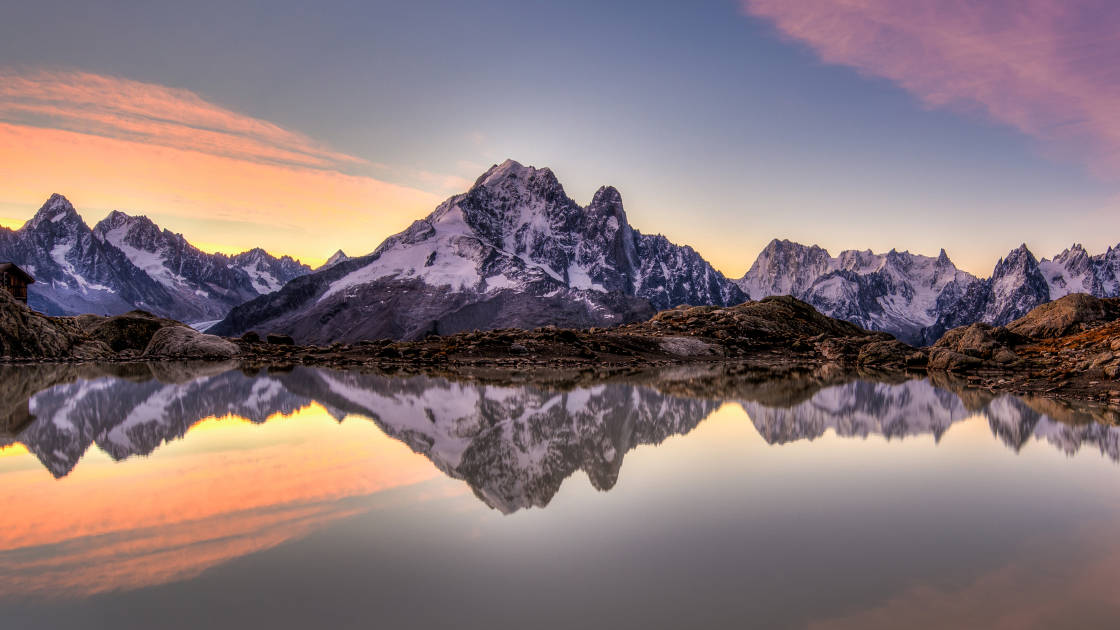
Homemade Energy Ball Recipe
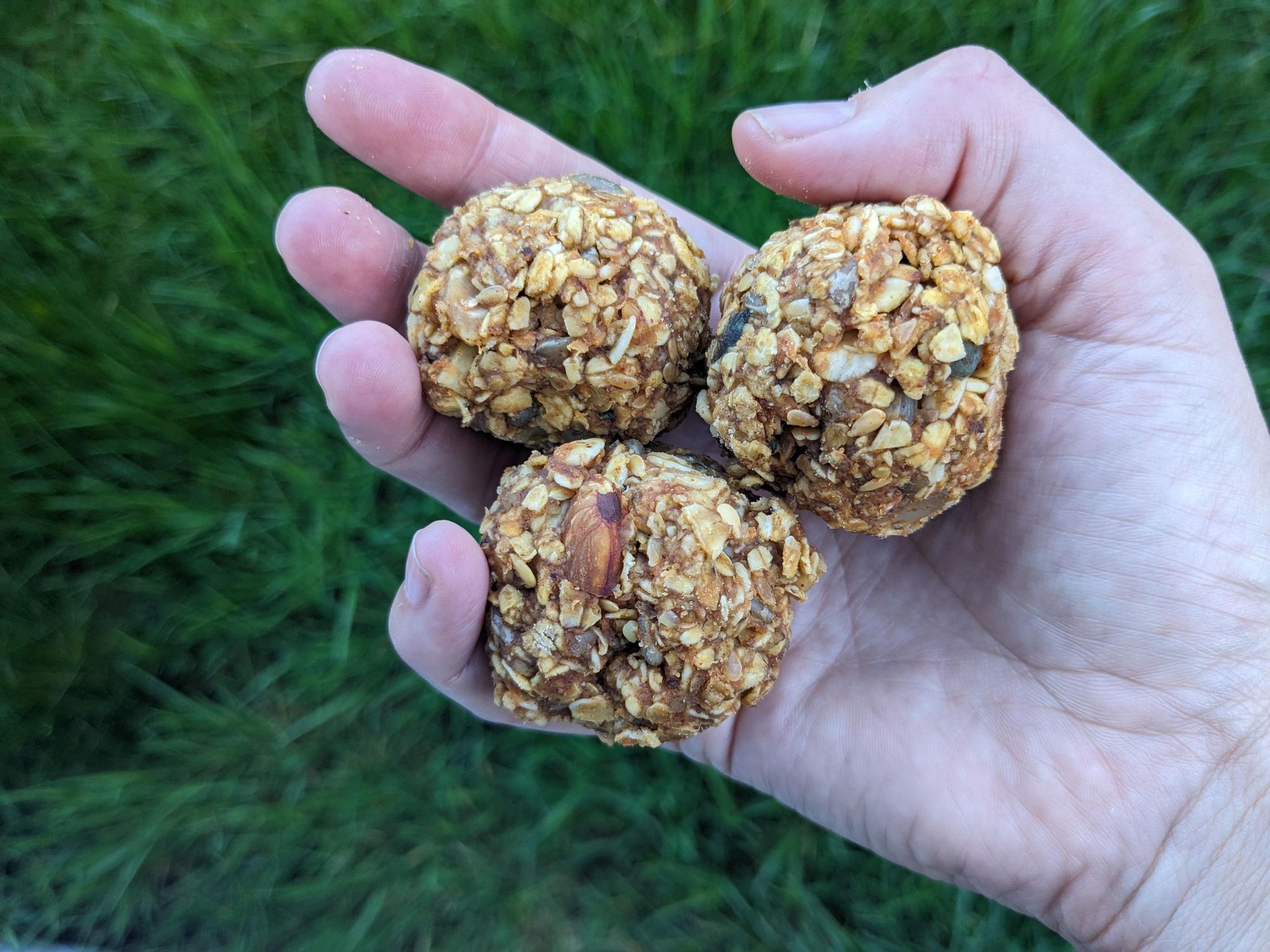
These no-bake energy balls are super versatile, consisting of oats, nut butter, a sweetener and ingredients to mix in, all of which can be substituted for other options. This recipe lists some of the potential variations.
Ingredients:
1 cup of oats
2/3 cup of peanut butter (I bulk-buy Whole Earth) OR almond butter
1/3 cup of natural sweetener, like maple syrup OR honey OR date syrup
3/4 cup of 'mix ins'. The options include (but are not limited to) - any type of nut, mixed seeds, toasted coconut, dried fruit such as dates or cranberries, cacao nibs, chocolate chips
1/2 tsp vanilla extract
1 tbsp milled flax seed OR protein powder (optional)
A sprinkle of cinnamon (optional) OR ground ginger
A pinch of sea salt (optional)
Method
- Add your oats to a large mixing bowl, followed by your 'mix ins' of choice.
- Add your wet ingredients - the nut butter and sweetener.
- Mix well together with a spoon. The mixture should stick together and if you pick some up it should be 'rollable'. If it's too dry, mix in another tablespoon of peanut butter. If it's too wet, add some more oats.
- Roll into balls - depending on the size, you should get around 12-16.
- Done! You'll need to refrigerate them before you take them out on your hike, just so the ingredients stick together - they can also be frozen.
Savoury Snacks
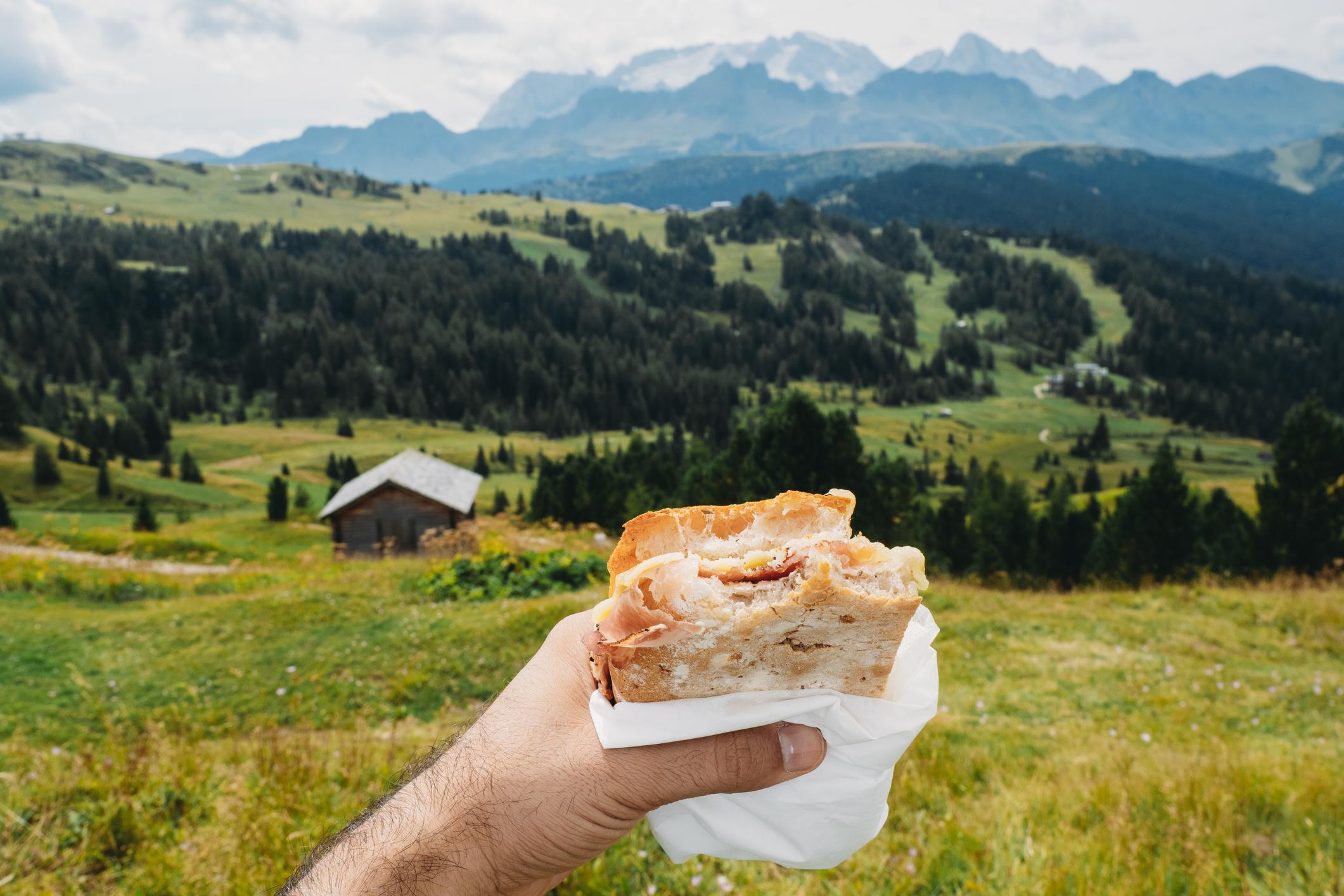
Where to even begin... If you can fit it in your rucksack sensibly, you can eat it on a hike. There are so many options. You might pack crisps of any variety, or nuts and seeds.
To get your protein in, people pack mini pork pies, scotch eggs, cocktail sausages and pasties. If you're going for more than a couple of days, Peperami or jerky won't go off so easily. Cheese can last a few days if the weather isn't too hot. Squeezy cheese (ugh) and squeezy bacon cheese (screaming intensifies) are common sights on expeditions. They're a bit like Marmite, either you're a fanatic or won't go near them.
Some sort of veggie spread might work for you. Or perhaps another classic: peanut butter. Whether you eat it on crackers and oat cakes or straight out the tub is down to your life choices. You can even buy it in squeezable pouches, a bit like baby food - another thing that occasionally makes it onto expeditions.
Fresh fruit and vegetables will taste better during a hike than they ever have. Choose things that are unlikely to get squashed or wrap them up carefully. Apples, oranges, bananas, peaches, plums, melons... anything goes! Make sure to take any peels or cores back home with you. As for vegetables, think cucumbers and carrots - anything with a refreshing crunch.
You've got a rucksack full of snacks! How about a hiking adventure to go with it?



